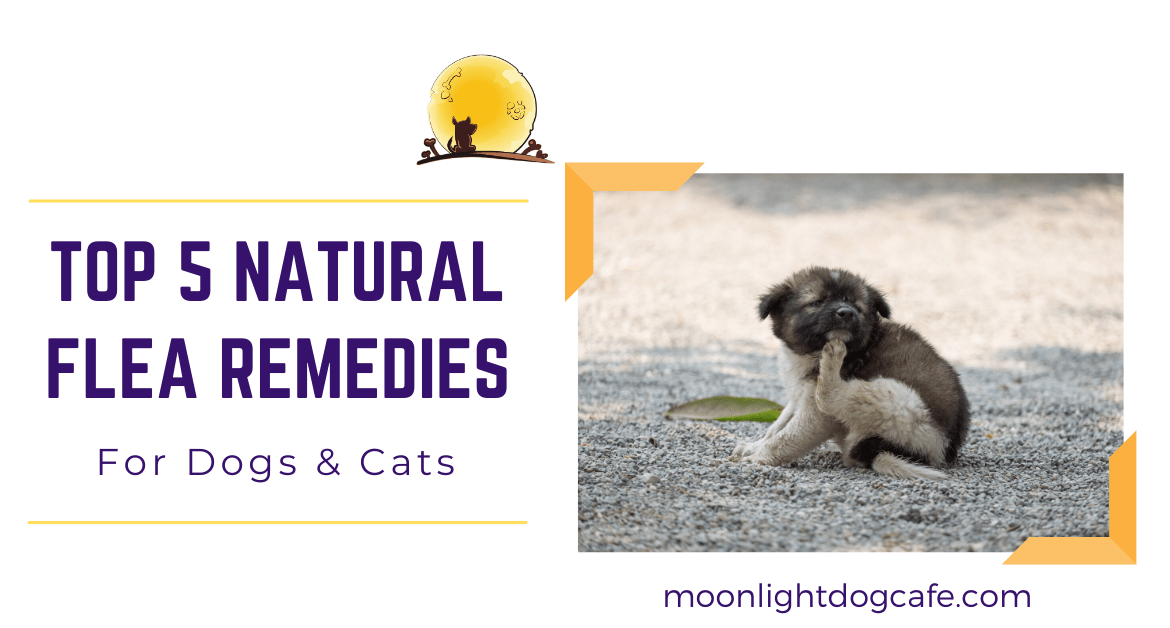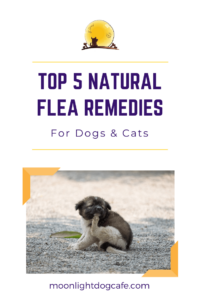
Best Flea Treatment For Dogs & Cats In Canada
Best flea treatment for dogs and cats
As the weather warms up, pet owners are rushing to buy various flea treatment for their dogs and cats.
However, the best flea treatment for dogs and cats is essential year round. Fleas are opportunistic pests jumping between heat sources. It may be freezing outside, however fleas may remain as eggs all around your warmed up house till your pet passes by. Adult fleas will die within about five days at -1°C. Eggs on the other hand can remain at low temperatures for a while.
We think using chemical spot-on flea treatments are unhealthy for your dog/ cat and will discuss the best flea treatment for dogs or cats. Natural flea prevention and treatment is useful for all dogs and cats in general but particularly for dogs or cats with sensitive skin, or have had seizures.
What is the best flea treatment for dogs and cats?
Chemical spot-on treatments which are put on your dog or cat are considered PESTICIDES. The US Environmental Protection Agency, has jurisdiction for chemical spot-on products as opposed to the FDA. As such, these pesticides when first put on will be rubbed on your couch and indoor environment, absorbed through your pet’s skin. We’d personally rather avoid it since they typically say “considered safe” until you read the potential side effects.
We believe that if the label for your flea treatment for dogs says “keep away from children” then it shouldn’t be in your dog or cat’s system.
Here are some of the side effects of chemical flea “medications”:
Symptoms can range from allergies, vomiting, diarrhea, depression, ataxia (uncoordinated movements) to muscle tremors and death, which tends to happen more often in smaller dogs.

What are some side effects for flea/ tick “medications” like Advantage/ Revolution?
It is a misnomer to call these flea medications as they are technically Pesticides. The active ingredients for these pesticides include Cyphenothrin (brand: Sentry’s Pro XFC) and Permethrin (brand: K-9 Advantix and some Sergeant’s products). In addition, the inert ingredients are also said to contribute to toxicity according to the EPA. How about the typical flea treatments for dogs and cats you see around e.g. Advantage (imidacloprid and pyriproxyfen) and Frontline (fipronil)?
- Imidacloprid has been known to cause vomiting, salivation as well as affect your pet’s brain and nervous system. As a side note, scientists are investigating its link to the death of honey bees.
- Pyriproxyfen has potential adverse liver effects long term in both dogs and cats.
- Fipronil on the other hand is a neurotoxin and carcinogen and can also result in organ damage.
- Revolution, Trifexis, Nexgard, Bravecto and Simparica are also used as flea treatment in dogs and cats. We’ve already talked about these in the context of Heartworm medication for dogs. A quick summary from that blog shows that the active ingredients included ivermectin, moxidectin and (selamectin).
Heartgard has ivermectin, Proheart6 has moxidectin and Revolution uses selamectin.
An FDA study in 2004 showed adverse reactions ranging from depression, vomiting, limpness, licking lips, shaking, diarrhea, liver lesions, anaphylaxis, convulsions to severe cases of death. (See here for the heartworm prevention blog.)
Most of these pesticides are meant to kill fleas but if you have a pet allergic to flea bites, you’d might still get that reaction as the fleas are only killed after biting your pet for some medications. Same with Lyme disease as the tick will have to bite your pet to be killed. Not much of preventative in these cases.
Frontline and Advantage are contact killers.
We think the best flea and tick treatment should be the safest options as well.
What is the best natural flea treatment or prevention for dogs?
Black Sheep Organics Off-Leash Dog spray and Naturpet Outdoor Spray are some of the safest flea treatment for dogs. If your dog has had seizure and you do not want to add to the chemical burden, try these safe and effective flea treatment/ repellents for dogs.
Natural flea repellents for dogs typically contain neem oil, lemongrass or cedarwood to help prevent fleas, mosquitos and ticks.
Note that some of these have or are essential oils and should NOT be used on cats as they are toxic when ingested.
What should I do if I use chemical spot-on flea treatments for dogs or cats?
However, if you do use chemical spot-on treatments, talk to your vet about the lowest possible dose and frequency that may still benefit your pet.
As Dr. Karen Becker says, “No matter what combination of pest repellent systems you use, including chemical agents, your pet can still attract pests and parasites. In fact, even animals loaded with chemicals to the point of toxicosis can still, for example, acquire heartworm.”
Also ensure that you do not use dog medications on cats!
What is the best natural flea and tick treatment for dogs?
The tips we provide include daily things you can do for natural flea control for dogs.

- Keep your dog healthy as fleas are attracted first to unhealthy animals. This includes feeding a high quality bio-available preferably raw dog food and exercising your dog.
- B vitamins are important for a healthy nervous system. Vitamin B are water-soluble and generally your dog can easily obtain these from raw meats, organs, fish and vegetables.
- Use flea and tick herbal repellents that are topical or as flea collars that can be worn by dogs. These contain geranium oil in a proprietary blend that at worst may cause a skin reaction. For dogs with seizures, this may be some of the safest flea prevention.
- Talk to your holistic vet about adding fresh ground/chopped/minced garlic to your dog’s food. Garlic is a powerful antibiotic, antioxidant, anti-viral, anti-fungal and the list goes on. The concern about garlic poisoning is due to the thiosulphate in it, which is lower than what is in onions. The actual study, which set of this panic- “4 dogs were given 1.25 ml of garlic extract/kg of body weight (5 g of whole garlic/kg) intragastrically once a day for 7 days.” What does this mean?
-
- For a retriever weighing 35 kg, you would have to feed the dog, 175 g of garlic, which is the equivalent of a small apple. That is a lot of garlic!
- “However, no dog developed hemolytic anemia.” These were the results from the study.
- Please talk to your holistic vet about dosing right if you want to do this for your dog. At the right dose, garlic is beneficial to your dog. We’d recommend grating fresh garlic and letting it sit for about 10 min before feeding as it forms an enzyme called allicin, which is great for repelling pests and active for about an hour before becoming unstable. In addition, allicin is also shown to inhibit cancer formation.
-
- Do not over-vaccinate your dog. More pet vaccines are not better. For more information see Dr Shultz (expert in vaccinations recommendations)
- Lastly, to ensure your pets do not have heartworm or any tick diseases, ask your vet for SNAP 4Dx tests annually to check for these diseases.
What is the safest flea and tick prevention for cats?
Some of these tips will be similar to the ones for dogs. However, cats are more sensitive to a lot of chemicals so this list will be shorter.
- For indoor cats, flea and tick prevention is really not necessary. However, we understand that as pet owners, we get grossed out by the thought of fleas. Please do not rush to get a chemical flea treatments that is not necessary or not healthy for your cats.
- Keep your cat healthy as fleas are attracted first to unhealthy animals. This includes feeding a high quality bio-available preferably raw cat food and keeping your indoor cat active.
- Cats are more sensitive to thiosulphate than dogs so do not feed garlic to cats.
Step-by-step tips to get rid of fleas from your dog, cat and/or home
- Comb your dog using a flea comb for dogs over a piece of white paper. It can remove fleas or debris onto the paper. Sprinkle a bit of water on the paper and if any of the dust turns red then you have flea droppings.
- Wash your pets with grease-cutting soap as that gets rid of the oily outside of the flea, which allows them to survive in just water.
- Kitty may not be happy with you but this is a great way for starting to get rid of fleas.
- Once your pet is dry, FOOD GRADE Diatomaceous earth is a great way for getting rid of fleas on dogs and cats. It can be spread over your pet to dry out the fleas from outside in and can also be put into the food to expel internal pests like worms.
- For getting rid of fleas in the house due to your dog or cat, spread diatomaceous earth over your carpets and vacuum after 3 to 4 days (length of time for fleas to die).
- Apply 2 to 3 more times. In case, you are worried about silicosis when spreading, wear a mask.
- Wash all your bedding and pet’s bed in hot cycle in the washing machine to also help get rid of fleas.

